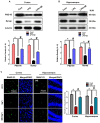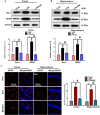Neuroprotective Effect of Quercetin Against the Detrimental Effects of LPS in the Adult Mouse Brain
- PMID: 30618732
- PMCID: PMC6297180
- DOI: 10.3389/fphar.2018.01383
Neuroprotective Effect of Quercetin Against the Detrimental Effects of LPS in the Adult Mouse Brain
Abstract
Chronic neuroinflammation is responsible for multiple neurodegenerative diseases, such as Alzheimer's disease, Parkinson's disease, and Huntington's disease. Lipopolysaccharide (LPS) is an essential component of the gram-negative bacterial cell wall and acts as a potent stimulator of neuroinflammation that mediates neurodegeneration. Quercetin is a natural flavonoid that is abundantly found in fruits and vegetables and has been shown to possess multiple forms of desirable biological activity including anti-inflammatory and antioxidant properties. This study aimed to evaluate the neuroprotective effect of quercetin against the detrimental effects of LPS, such as neuroinflammation-mediated neurodegeneration and synaptic/memory dysfunction, in adult mice. LPS [0.25 mg/kg/day, intraperitoneally (I.P.) injections for 1 week]-induced glial activation causes the secretion of cytokines/chemokines and other inflammatory mediators, which further activate the mitochondrial apoptotic pathway and neuronal degeneration. Compared to LPS alone, quercetin (30 mg/kg/day, I.P.) for 2 weeks (1 week prior to the LPS and 1 week cotreated with LPS) significantly reduced activated gliosis and various inflammatory markers and prevented neuroinflammation in the cortex and hippocampus of adult mice. Furthermore, quercetin rescued the mitochondrial apoptotic pathway and neuronal degeneration by regulating Bax/Bcl2, and decreasing activated cytochrome c, caspase-3 activity and cleaving PARP-1 in the cortical and hippocampal regions of the mouse brain. The quercetin treatment significantly reversed the LPS-induced synaptic loss in the cortex and hippocampus of the adult mouse brain and improved the memory performance of the LPS-treated mice. In summary, our results demonstrate that natural flavonoids such as quercetin can be beneficial against LPS-induced neurotoxicity in adult mice.
Keywords: activated gliosis; lipopolysaccharide; memory performance; natural flavonoids; neuroinflammation; neurotoxicity; quercetin.
Figures







References
-
- Ali T., Kim T., Rehman S. U., Khan F. U., Khan M. Ikram M., et al. (2018). Natural dietary supplementaion of anthocyanins via PI3K/Akt/Nrf2/HO-1 pathways mitigates oxidative stress, neurodegeneration, and memory impairment in a mouse model of Alzheimer’s disease. Mol. Neurobiol. 55 6076–6093. 10.1007/s12035-017-0798-6 - DOI - PubMed
LinkOut - more resources
Full Text Sources
Research Materials
Miscellaneous

